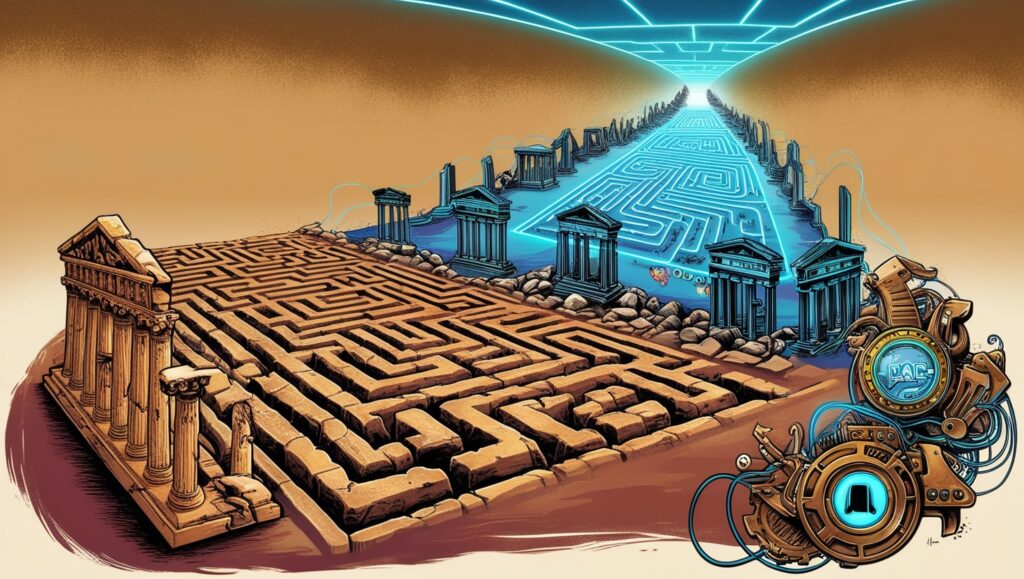
Mazes have always fascinated people, presenting a challenge that taps into our natural desire to navigate, explore, and solve. From the mythical labyrinths of ancient civilizations to today’s high-tech, digital mazes, these challenges have evolved but retained their timeless charm. In this blog, we’ll trace the rich history of maze games, from their earliest origins to their modern-day digital incarnations like the Gotilo app.
1. The Origins of Mazes: Mythology and Ancient Civilizations
The story of the maze begins thousands of years ago with one of the most famous myths of all time—the Labyrinth of Crete. According to Greek mythology, the Minotaur, a fearsome creature with the body of a man and the head of a bull, was imprisoned in a massive labyrinth built by Daedalus. It was so complex that no one could escape it until Theseus, with the help of Ariadne’s thread, found his way out after defeating the Minotaur. This tale established the maze as a symbol of mystery, challenge, and intellectual conquest.
Historically, mazes appeared in various ancient civilizations. The Egyptian labyrinth was described as a massive complex of interconnecting chambers, designed to confuse and disorient anyone who entered. Labyrinths and mazes were also prominent in medieval churches, often laid out as floor designs that pilgrims could trace as a symbolic journey of spiritual discovery.
For many cultures, the maze became more than just a challenge—it was a metaphor for the complexity of life, faith, and the human experience.
2. Mazes in Art and Culture
Mazes transcended mere entertainment and found a place in the artistic and cultural expressions of many societies. During the Renaissance, mazes appeared as motifs in art and architecture, often symbolizing the winding paths of human existence. Hedge mazes, particularly popular in European palaces and estates, became symbols of wealth and power, offering nobles the opportunity to entertain guests with both leisure and challenge.
Folklore in various cultures also frequently included mazes and labyrinths, often representing difficult choices or the journey of a hero. As the maze continued to evolve, its presence in culture remained tied to its symbolism of complexity and exploration.
3. The Birth of Mazes in the 19th and 20th Centuries
The evolution of mazes truly took off in the 19th and 20th centuries. Paper mazes became popular, appearing in books that challenged readers to find their way through intricately drawn paths. These mazes captivated people of all ages, creating a new form of entertainment that was accessible and portable.
Soon, board games and interactive physical mazes followed suit, allowing players to manipulate pieces through maze-like challenges. The influence of these early forms paved the way for more complex challenges and gave rise to the idea that mazes could be a mental exercise as much as a visual one.
4. The Digital Revolution: Maze Games in Video Game History
With the advent of digital technology, maze games experienced a revolutionary transformation. One of the earliest digital maze games was “Amazing Maze” (1976), a simple game where players navigated through a series of mazes. This paved the way for more iconic games like Pac-Man (1980), which took the concept of a maze and added elements of strategy, pursuit, and survival.
Pac-Man’s blend of maze navigation with action gaming captured the hearts of millions, becoming a cultural phenomenon. During the 1980s and 1990s, video games like The Legend of Zelda incorporated maze-like dungeons that players had to explore, solidifying the maze as a key element of video game design.
5. The Evolution of Mazes in Modern Gaming
In the 21st century, mazes have continued to evolve, with digital technology providing new ways to experience these challenges. Virtual Reality (VR) and 3D maze games allow players to immerse themselves fully in the challenge, as they navigate labyrinths in realistic, interactive environments. Popular modern games like Portal and The Witness have taken maze-solving to a new level, blending complex storytelling and environmental challenges with maze-like structures.
Additionally, mobile games have made mazes more accessible than ever. One of the standout modern maze games is the Gotilo Maze app, a unique game that brings the classic maze experience into the digital age. Gotilo Maze offers players intricate and challenging mazes, beautifully designed to test spatial awareness and strategic thinking. With varying levels of difficulty, players can work their way from simple mazes to more complex designs, making Gotilo a perfect modern-day reflection of the maze’s timeless appeal.
6. The Timeless Appeal of Maze Games
So why do we love maze games? The answer lies in our innate love for solving problems and overcoming challenges. Mazes require us to engage both our spatial awareness and our critical thinking skills. The satisfaction of finding a way through a maze—whether it’s a physical hedge maze, a paper challenge, or a digital labyrinth—is deeply rewarding.
Mazes are also timeless because they resonate with us on a psychological level. They symbolize journeys, choices, and the unknown, allowing us to project our life’s challenges onto the maze and find a sense of resolution as we reach the goal. This is why maze games like Gotilo Maze continue to captivate us, even in a world dominated by increasingly complex gaming experiences.
Conclusion
From the mythic labyrinths of ancient Greece to the immersive digital worlds of today’s maze games, the evolution of the maze has been a fascinating journey. Mazes have survived as a form of entertainment and intellectual challenge because they engage us on multiple levels—mentally, visually, and symbolically. As games like Gotilo Maze show, the maze remains a relevant and beloved genre, blending ancient traditions with modern technology to continue captivating players worldwide.
As we look to the future, the possibilities for maze games are endless, but one thing is certain: the timeless appeal of solving a maze will never fade.
Gotilo Maze is available for download now, offering you the chance to dive into a world of modern mazes that echo the rich history of this classic challenge!